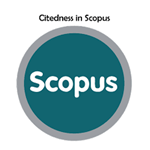Probabilitas Side Effects of Herbal Medicine di Kota Gorontalo
Abstract
Keywords
Full Text:
PDFReferences
N. R. MAWADHA, I. G. FEBRYANO, M. K. TSANI, and D. DURYAT, "Utilization of medicinal plants by the Lintang Tribe Community in Talang Baru Village, Empat Lawang District, Indonesia" Asian Journal of Ethnobiology, vol. 6, no. 1, pp. 20-25, 2023, doi: 10.13057/asianjethnobiol/y060103.
W. Utaminingrum, Nofrianti, and D. Hartanti, "Diversity and use of medicinal plants for traditional women's health care in Northern Banyumas, Indonesia" Biodiversitas, vol. 23, no. 4, pp. 1970-1976, 2022, doi: 10.13057/biodiv/d230431.
A. R. Kusumo, F. Y. Wiyoga, H. P. Perdana, I. Khairunnisa, R. I. Suhandi, and S. S. Prastika, "Jamu Tradisional Indonesia: Tingkatkan Imunitas Tubuh Secara Alami Selama Pandemi" Jurnal Layanan Masyarakat (Journal of Public Services), vol. 4, no. 2, p. 465, 2020, doi: 10.20473/jlm.v4i2.2020.465-471.
I. S. Pradipta et al., "Traditional medicine users in a treated chronic disease population: a cross-sectional study in Indonesia" BMC Complementary Medicine and Therapies, vol. 23, no. 1, pp. 1-9, 2023, doi: 10.1186/s12906-023-03947-4.
E. P. Ratih and M. S. Utami, "Efektivitas Terapi Kognitif Perilakuan untuk Meningkatkan Efikasi Diri Abstinen NAPZA" Gadjah Mada Journal of Professional Psychology (GamaJPP), vol. 4, no. 2, p. 185, 2019, doi: 10.22146/gamajpp.46327.
M. B. MARDIYANTO et al., "Plants as herbal medicine at Nguter Traditional Market, Sukoharjo, Central Java, Indonesia" Asian Journal of Ethnobiology, vol. 6, no. 1, pp. 65-74, 2023, doi: 10.13057/asianjethnobiol/y060108.
A. Permadi, S. Yuliani, I. Wahyuningsih, and I. Satar, "FORMULASI TABLET EKSTRAK KUNYIT (Curcuma longa L) SEBAGAI KANDIDAT ANTI DEMENSIA" Media Farmasi, vol. 17, no. 1, p. 70, 2021, doi: 10.32382/mf.v17i1.2057.
S. Safitri and G. Gustina, "Pembuatan Minuman Herbal Kunyit Asam sebagai Pereda Dismenorea" Jurnal Abdimas Kesehatan (JAK), vol. 5, no. 2, p. 224, 2023, doi: 10.36565/jak.v5i2.457.
Sofyan A.P. Kau, Zulkarnain Suleman, Lahaji, Mujizatullah, and Nazar Husain Hadi Pranata Wibawa, "GORONTALO WOMEN'S BE'ATI (BAI'AT): The Perspective of History, Culture and Islamic Law" Journal of Namibian Studies : History Politics Culture, vol. 33, pp. 174-200, 2023, doi: 10.59670/jns.v33i.502.
K. N. O. Orillaneda and Dr. L. H. Acero, "Ethnomedicinal Plants Used by Middle-Aged Residents in San Antonio, Tandag City, Surigao Del Sur, PhilippinesFull Text" International Journal on Bioinformatics & Biosciences, vol. 13, no. 1, pp. 63-72, 2023, doi: 10.5121/ijbb.2023.13106.
L. W. Limenh et al., "Assessment of Knowledge, Attitudes, and Practices of Traditional Healers toward Dosage Forms and Routes of Administration: A Cross"Sectional Study in Ethiopia" Evidence-Based Complementary and Alternative Medicine, vol. 2023, no. 1, 2023, doi: 10.1155/2023/7091233.
R. Rahmadani, C. Gunawan, G. Zhahera, M. Octavia, N. Sunnah, and R. A. Rahman, "Sosialisasi Dalam Menghindari Jamu Yang Mengandung Bahan Kimia Obat (BKO)" JMM - Jurnal Masyarakat Merdeka, vol. 5, no. 2, pp. 134-142, 2023, doi: 10.51213/jmm.v5i2.114.
S. Kazi, S. Bais, and R. Kharat, "An updated review on quality aspects of herbal drug and its formulations" International Journal of Pharmacognosy and Life Science, vol. 4, no. 1, pp. 32-36, 2023, doi: 10.33545/27072827.2023.v4.i1a.71.
J. Büttner, J. Büntzel, J. Büntzel, and J. Hübner, "Side-effects of Phytotherapeutics in Cancer Care - A Review of Inconsistencies in National and International Databases" Anticancer research, vol. 44, no. 10, pp. 4155-4164, 2024, doi: 10.21873/anticanres.17246.
N. Somaiya, A. Kibirige, and V. H. U. Eze, "Prevalence of Adverse Drug Reactions in HIV/AIDS Patients on Highly Active Anti-Retroviral Therapy in Bushenyi Medical Centre, Ishaka Adventist Hospital, and Kampala International University Teaching Hospital in Bushenyi District, Western Uganda" Newport International Journal of Scientific and Experimental Sciences, vol. 5, no. 1, pp. 21-31, 2024, doi: 10.59298/nijses/2024/10.5.12131.
M. Divakar, A. Ram, and K. Lalitha, "Incidence of Adverse Drug Reactions (ADRs) and their Determinants among Sputum-Positive Pulmonary TB Patients in A Metropolitan Area, Bengaluru: A Prospective Study" National Journal of Community Medicine, vol. 14, no. 10, pp. 628-634, 2023, doi: 10.55489/njcm.141020233057.
V. Survase et al., "Identification and Reporting of Adverse Drug Reactions in the Pharmacovigilance Center of a Tertiary Care Hospital" Asian Journal of Pharmaceutical and Clinical Research, vol. 16, no. 5, pp. 197-200, 2023, doi: 10.22159/ajpcr.2023.v16i5.46973.
W. Srisuriyachanchai, A. R. Cox, S. Kampichit, and N. Jarernsiripornkul, "Severity and Management of Adverse Drug Reactions Reported by Patients and Healthcare Professionals: A Cross-Sectional Survey" International Journal of Environmental Research and Public Health, vol. 20, no. 4, 2023, doi: 10.3390/ijerph20043725.
G. S., S. Devipriya, S. K. M., and R. B. C., "Analysis of individual case safety reports of spontaneous reporting in adverse drug reaction monitoring centre at a tertiary care hospital" International Journal of Basic & Clinical Pharmacology, vol. 11, no. 6, p. 587, 2022, doi: 10.18203/2319-2003.ijbcp20222739.
P. Pradhan et al., "Causality assessment of adverse drug reaction: A narrative review to find the most exhaustive and easy-to-use tool in post-authorization settings" Journal of Applied Biomedicine, vol. 21, no. 2, pp. 59-66, 2023, doi: 10.32725/jab.2023.010.
H. Jiang et al., "Adverse drug reactions and correlations with drug-drug interactions: A retrospective study of reports from 2011 to 2020" Frontiers in Pharmacology, vol. 13, no. August, pp. 1-14, 2022, doi: 10.3389/fphar.2022.923939.
K. Hamada et al., "Estimating Culprit Drugs for Adverse Drug Reactions Based on Bayesian Inference" Clinical Pharmacology and Therapeutics, vol. 113, no. 5, pp. 1117-1124, 2023, doi: 10.1002/cpt.2867.
DOI: https://doi.org/10.37311/ijpe.v4i3.27733
Refbacks
- There are currently no refbacks.
Copyright (c) 2024 Teti Sutriyati Tuloli, Madania Madania, Robert Tungadi, Zulfiayu Sapiun

Indonesian Journal of Pharmaceutical Education is licensed under a Creative Commons Attribution-NonCommercial-ShareAlike 4.0 International License.



